Technical Sciences Paper 1 Questions - Grade 12 September 2021 Preparatory Exams
Share via Whatsapp Join our WhatsApp Group Join our Telegram GroupINSTRUCTIONS AND INFORMATION
Read the following instructions carefully before answering the questions.
- Write your FULL NAME and SURNAME in the appropriate spaces on the ANSWER BOOK.
- Answer ALL the questions.
- Start each question on a NEW page in the ANSWER BOOK.
- You may use a non-programmable calculator.
- You may use appropriate mathematical instruments.
- Number the answers correctly according to the numbering system used in this question paper.
- Show ALL formulae and substitutions in ALL calculations.
- Round off your FINAL numerical answers to a minimum of TWO decimal places.
- Give brief motivations, discussions, et cetera where required.
- You are advised to use the attached DATA SHEETS.
- Write neatly and legibly.
QUESTIONS
QUESTION 1: MULTIPLE-CHOICE QUESTIONS
Various options are provided as possible answers to the following questions. Choose the answer and write only the letter (A–D) next to the question numbers (1.1 to 1.10) in the ANSWER BOOK.
1.1 A physical quantity that is described as a measure of the resistance of a body to a change in its state of rest or state of motion with constant velocity is called …
- momentum.
- impulse.
- energy.
- inertia. (2)
1.2 A constant net force of 2 N, to the right, acts on a box as shown below. The kinetic frictional force between the surface and the block is 2 N.
What will happen to the box?
The box will …
- not move.
- move with constant velocity to the right.
- move with constant acceleration to the left.
- move with constant acceleration to the right. (2)
1.3 The acceleration vs 1/mass graph for a body is given below.
The physical quantity that is represented by the gradient of the graph is …
- net force.
- velocity.
- momentum.
- displacement. (2)
1.4 Two identical trolleys collide head on with each other. The collision is INELASTIC.
Which ONE of the following is CORRECT regarding the total momentum and the total kinetic energy of the two trolleys during the collision?
Total momentum of the two trolleys is … | Total kinetic energy of the two trolleys is … | |
A | conserved | conserved |
B | conserved | not conserved |
C | not conserved | conserved |
D | not conserved | not conserved |
(2)
1.5 The work done to lift an object through a height h above the ground is 980 J. The work done to lift the same object through height of 2h above the ground would be …
- 490 J.
- 980 J.
- 1 960 J.
- 2 940 J. (2)
1.6 Identical steel balls of equal mass are dropped at the same time into test tubes containing motor oils of different viscosities.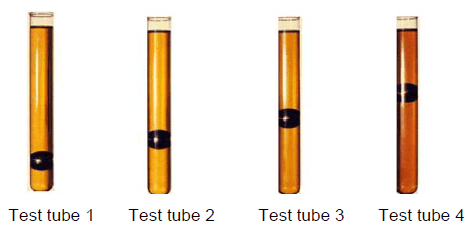
Motor oil with LOWEST viscosity is contained in test tube …
- 1.
- 2.
- 3.
- 4. (2)
1.7 A ray of light is reflected by using a plane mirror as shown below. In the diagram angle P is equal to 71°.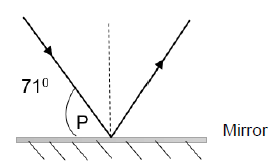
Which ONE of the following is CORRECT regarding the angle of incidence and the angle of reflection?
Angle of incidence | Angle of reflection | |
A | 71° | 71° |
B | 19° | 71° |
C | 19° | 19° |
D | 71° | 19° |
(2)
1.8 Which ONE of the following regarding the dispersion of white light in a glass prism is TRUE?
- Blue light is more refracted than red light.
- Red light is more refracted than blue light.
- Both blue and red light are equally refracted.
- Violet light is refracted less than blue light. (2)
1.9 The magnetic field around a current carrying conductor is shown in the diagram. X indicates that the current flows into the plane of the paper.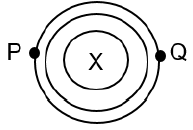
Which ONE of the following is CORRECT regarding the direction of the field and the rule to find the direction of the field?
Direction of the field | Rule to find the direction | |
A | P to Q, clockwise | Right-hand thumb |
B | P to Q, anticlockwise | Left-hand thumb |
C | Q to P, clockwise | Left-hand thumb |
D | Q to P, anticlockwise | Right-hand thumb |
(2)
1.10 Resistors in the circuit diagram given below are identical.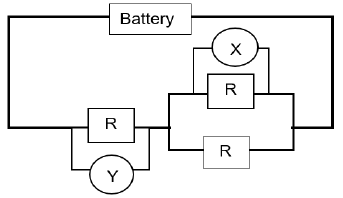
If voltmeter X records a potential difference of V, then the reading on voltmeter Y would be …
- ½V.
- V.
- 2V.
- 4V. (2)
[20]
QUESTION 2: MATCH ITEMS
Choose a term/phrase from COLUMN B that matches a description in COLUMN A. Write only the letter (A–I) next to the question numbers (2.1 to 2.8) in the ANSWER BOOK, for example 2.9 J. Use each term in COLUMN B only ONCE.
COLUMN A | COLUMN B | ||
2.1 | Rate of change of momentum | A | Impulse |
2.2 | Change in momentum | B | Thrust |
2.3 | The internal restoring force per unit area | C | Optic axis |
2.4 | The normal force exerted by a liquid at rest on a given surface in contact with it | D | Capacitor |
2.5 | The central horizontal line that passes through centres of curvature of lens surfaces | E | Tension |
2.6 | A device that converts electrical energy into mechanical energy | F | Net force |
2.7 | The force acting on a string or a rope | G | Stress |
2.8 | A device used for separation of frequencies between the woofer (base) speaker and tweeter (high pitch) speaker/electronic noise filtering | H | Principal axis |
I | Electric motor | ||
(8 x 1) [8]
QUESTION 3
A boy carrying a shotput ball stands on a stationary trolley as shown in the figure below. Assume that the trolley is standing on a frictionless surface.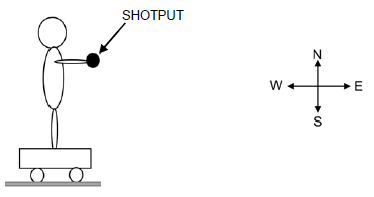
3.1 Write down the ACTION-REACTION pairs for the following forces:
3.1.1 Weight of the boy (1)
3.1.2 Normal force of the ground on trolley (1)
The boy throws the ball in an easterly direction.
3.2 In which direction will the boy-trolley system move after the ball is thrown? (1)
3.3 State the law that explains your answer to QUESTION 3.2 above. (2)
[5]
QUESTION 4
A bricklayer pulls a trolley with a force of 200 N at an angle of 35° to the horizontal on a rough surface as shown in the diagram below.
The mass of trolley is 60 kg and the coefficient of kinetic friction between the surface and trolley is 0,2.
4.1 State Newton’s Second law of motion in words. (2)
4.2 Draw a labelled freebody diagram of all the forces acting on the trolley. (4)
4.3 Calculate the magnitude of kinetic friction acting between the surface and the trolley. (4)
4.4 Calculate the magnitude of acceleration of the trolley. (3)
4.5 What would happen to the acceleration calculated in QUESTION 4.4, if the angle between the force applied and horizontal is increased to 50°? Write down only INCREASES, DECREASES or REMAINS THE SAME. Explain your answer. (3)
[16]
QUESTION 5
5.1 A car travels due east with an initial momentum of 20 000 kg.m.s-1 and an initial kinetic energy of 200 000 J.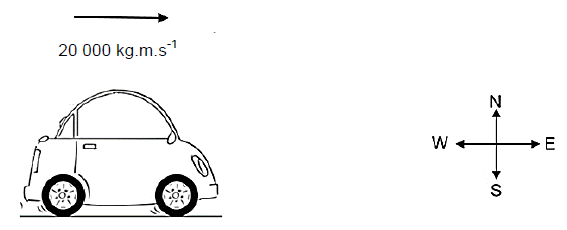
5.1.1 Is momentum a vector quantity? YES or NO. (1)
5.1.2 Calculate the initial velocity of the car. (4)
5.1.3 Calculate the mass of the car. (2)
5.2 Two blocks, P and Q, both at rest have a compressed spring between them. A third block R is in contact with block P as shown below.
After the spring is released blocks P and R moves as a combined unit to the left while block Q moves at a speed of 2 m.s-1 to the right as shown in the diagram below.
5.2.1 State the law of conservation of momentum. (2)
5.2.2 Calculate the speed of the block P and R combination after the collision. (4)
[13]
QUESTION 6
6.1 A bricklayer pulls a concrete block on a rough surface by applying a constant horizontal force of 300 N.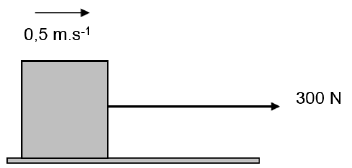
The bricklayer pulls the concrete block for 50 s and it moves with a constant speed of 0,5 m.s-1.
6.1.1 Define the term power. (2)
6.1.2 Calculate the power generated by the bricklayer. (3)
6.1.3 Calculate the work done by the bricklayer. (3)
6.1.4 What is the work done by the force of friction? Give a reason. (2)
6.2 A ball of mass 2 kg is released from point A at the top of curved frictionless track. Point A is at a height of 10 m above the ground. The ball travels to the lowest point B on the track and finally reaches point C.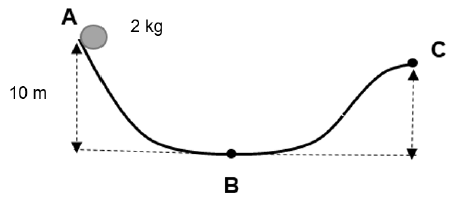
6.2.1 State the law of conservation of mechanical energy in words. (2)
Using energy principles to calculate the:
6.2.2 Speed of the ball at the point B (4)
6.2.3 Height of point C above the ground if the speed of the ball at C is half the speed at B (4)
[20]
QUESTION 7
7.1 One end of a steel rod of length 0,9 m with a cross-sectional area 0,01 m2 is attached to a ceiling. A force 500 N is applied to the other end of the rod as shown in the diagram below.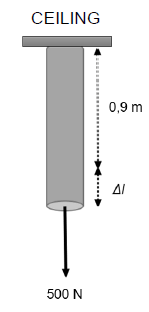
The modulus of elasticity of the steel rod is 200 × 109 Pa.
7.1.1 State Hooke’s law. (2)
7.1.2 Calculate the stress the steel rod experiences. (3)
7.1.3 Calculate the change in length, Δl, of the steel rod after the application of the force. (6)
7.1.4 How does the stress on the steel rod change if a steel rod with higher cross-sectional area is used? Write down only INCREASES, DECREASES or REMAINS THE SAME. (1)
7.2 Viscosity is an important property of a liquid and is temperature dependant. What is the effect of an increase in temperature on viscosity? (2)
7.3 A hydraulic system with pistons A and B is used to lift a vehicle of mass 1 200 kg in an auto garage. A force is applied on piston A while the car sits on piston B of area 0,7 m2. The area of piston A is 0,04 m2.
7.3.1 Calculate the force applied on piston A to lift the car. (4)
7.3.2 Give any TWO uses (other than one which is mentioned above) of hydraulics in technology. (2)
[20]
QUESTION 8
8.1 A coin of diameter 30 mm placed at a distance of 50 cm from a plane mirror as shown in the diagram.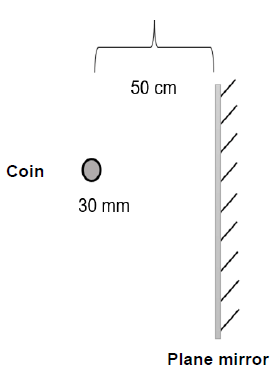
8.1.1 What is the size of the image formed? Write down LARGER THAN OBJECT, SMALLER THAN OBJECT or SAME AS OBJECT. (1)
8.1.2 How far from the object will the image be formed? (2)
8.2 The figure below shows the two rays of light passing from water to air. RAY 1 strikes the boundary between water and air at an angle β and it grazes over the surface of water.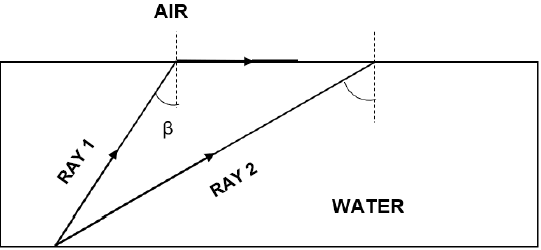
The critical angle for water is 48,8°.
8.2.1 What is the angle of incidence β for RAY 1? (1)
8.2.2 RAY 2 strikes at the boundary at an angle of incidence greater than the critical angle. Explain the path of the ray of light after it strikes the boundary. (2)
8.2.3 Name the phenomenon that takes place in QUESTION 8.2.2. (1)
8.3 An object of height 20 mm placed at a distance 24 cm away from a biconvex lens of focal length 12 cm.
8.3.1 What is the position of the image from the lens? (1)
8.3.2 What is the height of the image? (1)
8.3.3 Is the image formed real or virtual? (1)
8.3.4 Write down ONE use of a convex lens. (1)
[11]
QUESTION 9
9.1 Gamma rays and X-rays are part of an electromagnetic spectrum.
9.1.1 Which RADIATION has photons with the HIGHEST energy? GAMMA RAYS or X-RAYS (1)
9.1.2 Give ONE use of gamma rays. (1)
9.2 An X-ray photon has a wavelength of 1 × 10-10 m.
9.2.1 Define a photon. (2)
9.2.2 Calculate the energy of the X-ray photon. (5)
[9]
QUESTION 10
10.1 A capacitor with a capacitance of 480 × 10-9 F has two parallel plates placed 0,012 mm apart and the space between the plates is filled with air.
10.1.1 Define the term capacitor. (2)
10.1.2 Calculate the area of the plate of the capacitor. (3)
10.1.3 What would happen to the capacitance of the above capacitor if the distance between the plates is increased? Write only INCREASES, DECREASES or REMAINS THE SAME. (1)
10.2 Three resistors of resistances 3 Ω, 6 Ω and 9 Ω are shown in the diagram below. The battery has an emf of 24 V.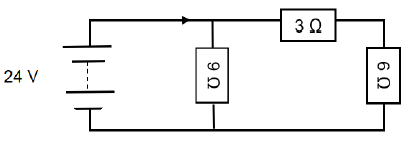
10.2.1 Calculate the total resistance of the circuit. (3)
10.2.2 Calculate the energy developed across 9 Ω resistor in 120 s. (3)
[12]
QUESTION 11
11.1 A learner conducts an experiment to demonstrate electromagnetic induction by pushing a magnet into a coil.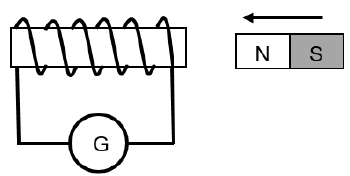
11.1.1 Define electromagnetic induction. (2) What will be observed on the galvanometer (G) needle …
11.1.2 when the magnet is pushed into the coil? (1)
11.1.3 if the magnet is kept stationary inside the coil? Explain your answer. (2)
11.2 The magnetic flux through a coil of wire contains two loops changes from 38 Wb to 50 Wb in 0,42 s. Calculate the emf induced in the coil. (3)
[8]
QUESTION 12
12.1 A transformer in a portable radio reduces 230 V AC to 9 V DC. The primary coil contains 400 turns.
12.1.1 Calculate the number of turns in the secondary coil. (3)
12.1.2 What type of transformer (step up or step down) is this? (1)
12.2 A simplified AC generator is shown in the diagram below.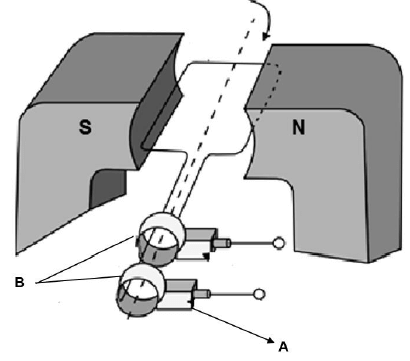
12.2.1 On which principle or law is the working of the generator based? (1)
12.2.2 Name the component labelled A. (1)
12.2.3 Name the component labelled B. (1)
12.2.4 How do you convert an AC generator into a DC generator? (1)
[8]
TOTAL: 150
DATA FOR TECHNICAL SCIENCES
GRADE 12
PAPER 1
TABLE 1: PHYSICAL CONSTANTS
NAME | SYMBOL | VALUE |
Acceleration due to gravity | g | 9,8 m·s-2 |
Speed of light in a vacuum | c | 3,0 x 108 m·s-1 |
Planck's constant | h | 6,63 x 10-34 J·s |
Permittivity of free space | ɛ0 | 8,85 × 10-12 F.m-1 |
TABLE 2: FORMULAE
FORCE
WORK, ENERGY AND POWER
ELASTICITY, VISCOSITY AND HYDRAULICS
WAVES, SOUND AND LIGHT
ELECTROSTATICS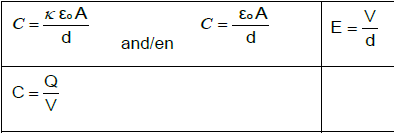
CURRENT ELECTRICITY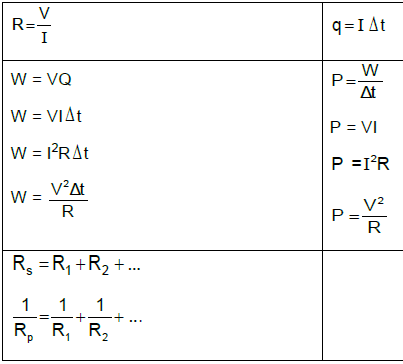
ELECTROMAGNETISM